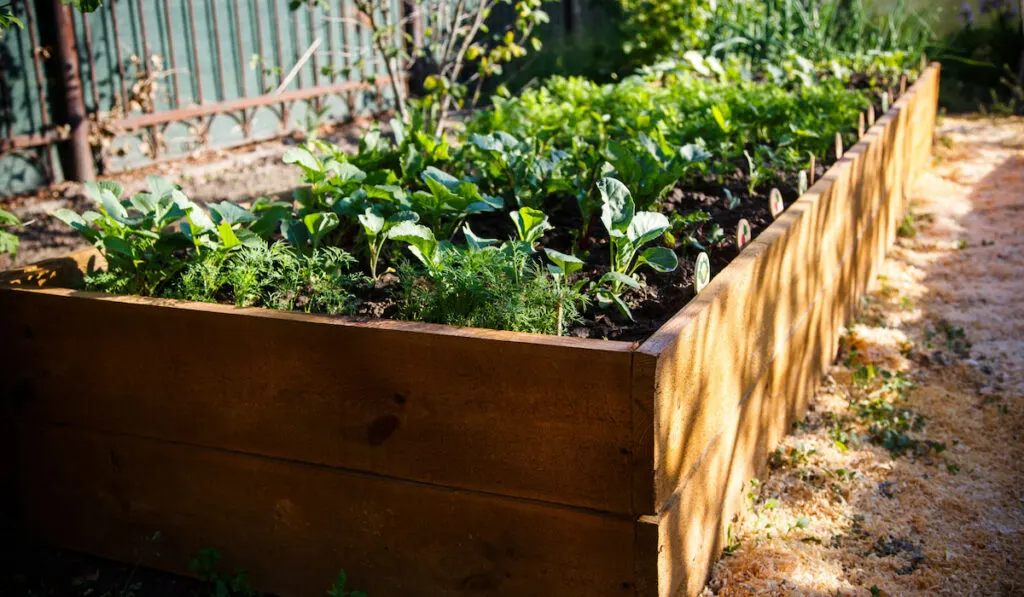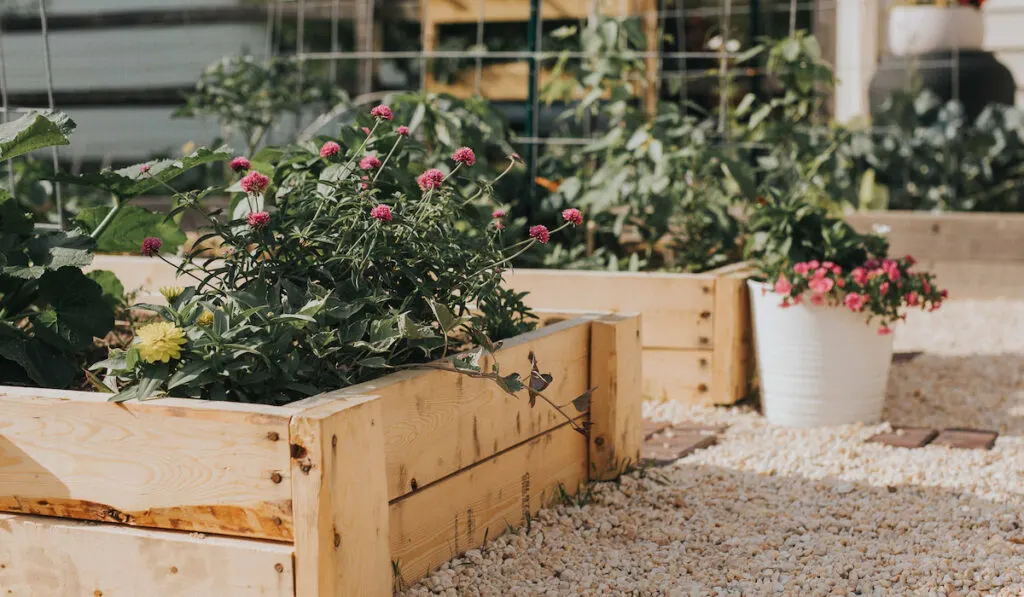Gardening is fun. Do you know what’s more fun for gardeners? Gardening on raised garden beds. Sometimes, though, gardeners may face the challenge of a rotting bed frame (especially when it’s made of wood).
Why do wooden raised garden bed frames rot and how can you keep a yours from rotting?
There are various ways to keep wooden garden bed frames from rotting. You can install a liner, treat the wood, keep the wood from gathering moisture, and so on. The most effective way to prevent rotting is to stop moisture from reaching the frame.

Table of Contents
How to Keep a Wooden Raised Garden Bed Frame from Rotting
There are several ways to keep wooden garden beds from rotting. The suggestions listed below are arranged from most to least recommended:
1. Install a Liner
A liner is any non-permeable material used to demarcate the raised bed soil from the bed or the plain ground.
Vertical liners separate the raised garden bed frame from the soil while horizontal liners separate the plain ground from the raised bed soil.
Liners do not permit water to flow through them. This means that installing a liner is an effective way of preventing moisture from reaching the wooden frame. The most effective option is to use vertical liners in your raised bed.
Note that it is easier to install liners when there is no soil in the raised bed yet. If you have already filled the bed with soil and you want to install a liner, you’ll need to scoop off the soil at the edge of the raised bed.
You should be careful when using horizontal liners because while they prevent water from draining off the raised bed, your bed might become damp if you do not water cautiously.
2. Use Treated Wood
Treated wood is any wood coated with chemicals and oils to prevent moisture and pests from reaching the wood. Treated wood is also coated with beautiful paints, so treated wood looks more aesthetically pleasing.
You should only install woods treated with plant-safe chemicals and oils. An example of plant-safe oil is Linseed oil. If you use wood coated with toxic chemicals, it can affect the growth and health of your plants.
3. Treat an Untreated Wood before Installing
What if you already bought your wood and it’s untreated? Before installing it into the raised bed, you should treat the wood to increase its durability and prevent it from rotting.
Later in this article, you will learn how to treat untreated wood.
4. Insert a Layer of Barrier between the Wooden Frame and Soil
This is an effective trick used by experienced gardeners for various reasons. You should insert objects such as stones, twigs, etc. between the soil and frame. This barrier prevents water or moisture from gathering at the wooden frame as the water can easily drain away.
Aside from the purpose of preventing wooden frames from rotting, the technique of inserting barriers between soil and frame also helps with soil aeration and allows oxygen to reach the roots of your plants.
5. Place the Wooden Frame on a Foundation Made from another Material
Just imagine a raised garden bed frame on top of another raised garden bed frame. Gardeners with high raised beds know that they need to place a frame on another frame to get a higher raised bed.
In this case, however, you are placing a wooden frame on a frame made with a different material.
Moisture is higher at regions close to the ground, so if you must use untreated wood, you need to install the wood far from the ground. Other materials suitable for the frame below are plastic/fiber, concrete, bricks, etc.
This design will also make your garden prettier.
How to Treat Wood for Raised Garden Bed Frame

First of all, you should understand that the different chemicals to treat wooden frames with have their own instructions to use. The procedure below is more applicable for plant-safe oil such as Linseed oil:
- Scrape the surface of the wood with a scraper, sandpaper, or anything that will make it smooth.
- Use a brush or spray to apply the oil over the surface of the wood.
- Allow the wood to dry.
- When dry, reapply oil over the surface. Concentrate on drier spots.
- Place the wood under direct sunlight for 3-5 hours.
- If there’s still oil (excess oil) on the surface of the wood, rub it off using a rag.
- Allow it to dry. That’s it.
The process is pretty easy. Remember to properly wash or dispose of the rag you used to remove excess oil from the wood. Oil makes the rag very flammable.
Other Materials You Can Use as Raised Garden Bed Frames
Here are some other materials you can use as raised garden bed frames:
- Concrete: Concrete is hard and durable. It helps stabilize the soil temperature. Raised beds made with concrete, however, are not mobile.
- Plastic: Making raised bed frames with plastics can make your garden beautiful to look at. A plastic frame is best for smaller raised beds that you intend to move.
- Metal: The best metals for raised beds are stainless steel and aluminum. Note that metals conduct heat quickly, so they can quickly alter the temperature of the soil.
Related Questions and Answers

1. How long will Untreated Wood Last in Raised Beds?
According to the thickness of the wood and type of tree, it is gotten from, untreated wood can last for 2-6 years in raised garden beds.
Other factors that can affect the duration of untreated wooden frames are:
- The concentration of Moisture: The more moisture, the lower the duration
- Soil Microbial Load: The more microbes are present in the soil, the higher chance that they would act on and destroy the wood.
- Width and Strength of Plant Roots: If you grow plants with strong roots at the corners or edges of raised garden beds, they might destroy the frame in time. You should grow such plants in the middle.
If the conditions are just right, your untreated wooden frame might last longer than 6 years.
2. What Causes Rotting in Raised Garden Bed Wood?
Wood rots for reasons such as temperature, microbes, oxygen, moisture, etc. You should also note that wood is organic and everything organic decomposes with time.
Here ‘s how these factors affect wood decay:
- Microbes: When it comes to the decaying or decomposition of organic materials, microbes such as fungi and bacteria are the major suspects. When they act on a surface, they break it down.
- Moisture: For microbes to thrive, they need moisture. Aside from the presence of microbes, moisture also softens wood and makes it more susceptible to breaking.
- Oxygen: Decomposition is an aerobic activity that consumes a lot of oxygen.
All the factors listed above affect the quality of untreated wood. Wood also rots faster in higher temperatures.
3. Does the Raised Garden Bed Material Type and State Affect the Plants?
The type and state of your raised garden bed frame affect the plants in several ways:
- Temperature: If your raised bed frame is made of metal, plastic, or any material that easily conducts heat, the temperature of the raised bed soil will fluctuate faster than the rate at which your plants can adapt.
- Pests: When there are cracks or holes in your raised bed frame, pests such as grub worms and other invertebrates can get into the raised bed and damage your crops.
- Nutrients and Water: A raised garden bed frame with cracks easily leaches nutrients and water off the soil. This means that you’d have to water and give fertilizer to your plants more frequently.
Final Thoughts
You should use treated wood for your raised garden bed because it will last longer.
Untreated wood will rot in time. To prevent your wood from rotting, follow the tips in this article.
